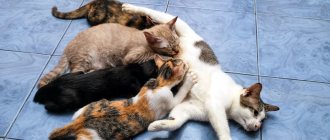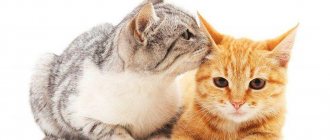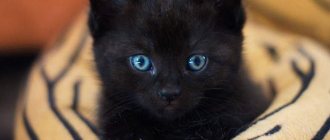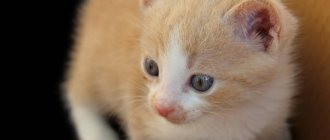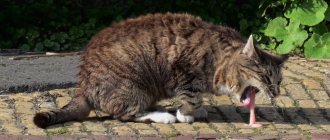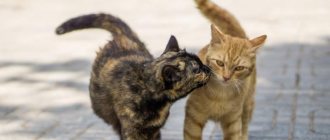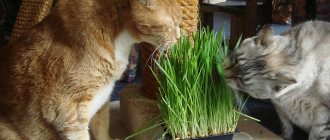What is needed for childbirth
It is necessary to prepare everything for childbirth in advance. Here is a complete list of what may be needed in case of emergency, although it is quite possible that nothing else will be needed besides the box, because almost every cat gives birth on its own.
- Soft and cozy box.
- Sterile gloves.
- A syringe to remove discharge from the kitten's nose and mouth.
- Clean cloths and towel. You can use toilet paper.
- Scissors.
- Antiseptic drug.
- Telephone for urgent calls to the doctor in case of complications in a giving birth cat.
- You may also need a cat milk replacer.
What drugs can be used
Above we have already touched upon the issue of contraception. Since birth control is necessary, it means that special medications are needed that can prevent mating. Moreover, given the age at which a cat can become pregnant, they should be used from a very young age. This issue is acute for owners of purebred animals during the rehabilitation period. Today there is a large selection of contraceptives for pets on the market. The following are especially popular: “Sex barrier”, “Stop-intim”, “Counter-sex”, “Gestrenol”, “Libidomin”.
How many kittens can a cat give birth to?
Cats reach sexual maturity at approximately 8-9 months. And before the age of 1 year, she is already able to become pregnant and bear offspring. However, experienced breeders understand that this is quite early, and consider such births to be risk factors, since the body is still too young.
Note to the owner! It is not recommended to breed domestic cats under 1 year of age, although in the case of backyard dwellers we cannot in any way influence this fact. It is advisable to wait until the cat is one and a half years old, when the cat’s body is stronger and ready to bear healthy offspring.
Primiparous cats usually give birth to a small litter: 1-3 babies. This is explained by the reproductive system not yet fully formed. Overmature felines also give birth to few kittens, since their reproductive function is already fading. Cats, healthy, well-groomed, in their prime, usually give birth to up to 6 kittens.
Nature has endowed a cat with only 8 nipples. This means that she can feed no more than 8 cubs at a time. But sometimes there are exceptions: cases have been recorded when a cat gave birth to more than 10 or even 12 kittens.
The maximum number that a domestic cat can give birth is difficult to determine. Some breeders believe that this depends on the number of nipples the cat has. If you count them and subtract the number 2 from the sum, the resulting number will indicate the maximum number of kittens that a cat can have. However, this method of determination cannot be called absolutely reliable, although it can be adopted for yourself.
Physiologically, the number of offspring is determined by the number of attachment sites of fertilized eggs to the walls of the uterus, which in cats consists of 2 horns. This is why young and older females give birth to fewer kittens than cats at optimal reproductive age.
It has been proven that street stray cats produce more offspring than domestic cats. Experts explain this fact by relaxation of the genetic apparatus in cats living in comfortable conditions. Representatives of the streets and courtyards are forced to leave behind numerous offspring in order to preserve the cat family.
When can this happen to a cat?
A cat can become pregnant when it reaches sexual maturity. But there is no need to rush into mating. The female is fully ready for mating only at the age of 14-15 months, and it is better to skip the first two heats. The cat must be healthy and strong before pregnancy, because bearing and feeding offspring requires a lot of effort. Early mating can have a negative impact on the health of the female and lead to the birth of sick kittens. Timely and healthy offspring can be expected with proper planning of the mating process. The male and female need to undergo a preliminary examination, receive anti-worm medications and vaccinations according to age.
How long does a cat's pregnancy last?
Let's figure out how many months or days a cat stays pregnant.
A cat's gestation period can vary up to 9 weeks. This is approximately 2 months. It is noteworthy that short-haired individuals usually bear babies for 58-68 days, long-haired ones - 63-72.
The course of pregnancy also depends on the number of kittens: if there are fewer than five, the “maternity leave” may be delayed; if there are more, the cat may give birth earlier.
The normal delay in labor is no more than a week. It is more dangerous if kittens are born a week ahead of schedule - they may die.
The characteristics of the Scottish Straight breed are described in the article below the picture.
You will learn about what you need to know to keep a Maremmo-Abruzzese Shepherd Dog at this link.
Yorkshire Terrier - hunter or glamorous thing:
Everyone's responsibility
At first glance, reproduction is a natural phenomenon. Moreover, many believe that childbirth is necessary and important for the health of the animal. But look around. Today there are so many abandoned, unhappy kittens, cats and female cats who need a family that allowing new ones to be born is simply a crime.
Everyone hopes that good hands will be found for every kitten that their pet has. And usually they are found, especially if the litter is spring. Children are taken to the dacha during the summer holidays for children. What happens in the fall? They are abandoned in summer cottages, left at bus stops, or simply thrown into the yard.
Therefore, think very carefully before allowing your pet near the cat. If she is not purebred, then it is best to sterilize her. Some owners, in the old fashioned way, drown newborns and bury them in the garden. Despite the apparent inhumanity, this is better than starvation and painful death.
When do you need veterinary help?
In most cases, the cat copes with the birth of kittens on her own. But there are times when the help of a loving owner is extremely necessary. Sometimes, due to fatigue and pain, a cat can “squeeze” a cub that is only halfway out. Most often, this happens if the kitten walks forward with its hind legs.
Such situations require immediate intervention. The easiest way to help is to grab the cat by the scruff of the neck so that it stands upright on its hind legs.
By switching to a new stimulus, the woman in labor will relax the vaginal muscles and the kitten will be born. If this does not help, then more radical measures should be taken. You need to carefully take the kitten with a gauze cloth (a clean cloth or a gynecological glove) and pull it out with light, rocking movements. This should be done at those moments when the cat begins to struggle.
Normal birth in British cats does not require specialist intervention. However, owners should observe how the cat behaves after giving birth. If certain symptoms occur, you should immediately call your nearest veterinary clinic.
We suggest you read: Fleas on a cat - how to identify and get rid of them
• labor does not begin more than 70 days after conception;
• there are signs of fever and increased temperature in cats before giving birth;
• fever in cats after birth;
• the appearance of bright red discharge from the vagina, lasting more than 10 minutes;
• unpleasant and pungent odor from the vagina;
• contractions in cats without continuation of labor for a long time (more than an hour);
• restless behavior of the cat after the termination of labor.
Diagnosis of pregnancy and precursors of childbirth
External symptoms of pregnancy may be false. In the early stages, only a veterinarian can diagnose pregnancy.
The following diagnostic methods exist:
- Blood test for hormones. Until the 30th day of pregnancy, the amount of progesterone in the blood increases significantly. 25 days after ovulation, the level of the hormone relaxin increases in the body.
- Palpation. At day 25 of pregnancy, the doctor can feel the embryos in the cat's abdomen.
- From 3-4 weeks, an ultrasound will help determine pregnancy.
- On the 40th day after mating, the skeletons of the kittens are visible on x-ray.
- A stethoscope can help you listen to the heartbeat of kittens in late pregnancy.
You should not palpate the cat’s belly yourself, as this can harm the female and kittens.
Signs that will help you understand that your cat is going into labor:
- The female eats less than usual or refuses to eat at all.
- The cat is acting restless and rushing around the house.
- The cat constantly licks the area between its hind legs.
- Breathing becomes frequent and shallow, shortness of breath appears.
Sensing the approach of birth, the cat will settle in its nest and will not leave until everything is over.
Preparing for childbirth
If according to signs the cat is expected to give birth within the next 24 hours, then you definitely need to prepare for this. It’s better to do this in advance, a few days in advance, so that everything is at hand. All preparation is carried out in several stages.
The expectant mother must get used to the parenting place in advance. Therefore, the box in which the birth will take place should appear in the house at least a week before the significant event. If this is not done, the pet will choose its own place. This could be a closet or just a secluded corner. At the same time, it is almost impossible to convince the pet to move into the box in this case.
We suggest you familiarize yourself with: Proper care and maintenance of the cockatoo apistogramma fish
Box requirements:
- the cat should be able to stretch out to its full height inside, and at the same time there should be enough space for the kittens;
- the height of the container should be approximately half a meter;
- the exit must be made in such a way that the mother can calmly get out and go back in, but the kittens cannot;
- A small soft pillow should be placed on the bottom, which should be wrapped in a waterproof cloth, and an absorbent cloth should be placed on top.
If before giving birth the cat did not enter the prepared house on its own, then it should be carried and placed inside. At the same time, she needs to be stroked and calmed down, and made to understand that it is better to give birth to offspring here.
How often can a cat give birth?
Without control of sexual behavior, a cat is capable of giving birth up to four to five times during the year. A lactating female retains the opportunity to become pregnant again. At the same time, frequent childbirth has a bad effect on the cat’s body. The optimal mating frequency is once every six months or less. The duration of the rehabilitation period between births should be more than five months. The reproductive period lasts from the first estrus until old age. In the cat family there is no such thing as menopause. It is not recommended to give birth to cats over 7 years old. At this age, it is too difficult to bear offspring, and the kittens may be weakened or sick. Reasonable organization of pregnancy and rest periods will ensure the cat a long, healthy life.
Age at which a cat can become pregnant
Many people wonder at what age a cat can become pregnant for the first time. Puberty can begin between 4 and 12 months of age during the first heat cycle. In individuals of different breeds and body types, the first heat does not appear at the same time. In the case of long-haired and large cats, it occurs when their age reaches 10-12 months. These cats include Norwegian, Siberian and Maine Coon. Small cats with short hair have an earlier development. They become sexually mature at the age of 4-5 months. Representatives of shorthairs are “British”, Siamese and Burmese cats.
Estrus is the name given to discharge from an animal's genitals. The following signs may indicate that heat is approaching:
- the pet's desire to receive more affection;
- friction against the owner's legs;
- rolling on the floor;
- tail wagging.
Important! Outdoor cats go into estrus 2 times a year in spring and autumn, and domestic cats - every month. The pet's body weight increases by 2-2.5 kg. Females are characterized by various external changes
However, people who got a cat for breeding should know that the onset of puberty does not mean that the female can already mate to produce offspring. The body of a cat less than 10 months old will not be able to bear and give birth to kittens for physiological reasons.
The pet's body weight increases by 2-2.5 kg. Females are characterized by various external changes. However, people who got a cat for breeding should know that the onset of puberty does not mean that the female can already mate to produce offspring. The body of a cat less than 10 months old will not be able to bear and give birth to kittens for physiological reasons.
After the onset of heat, the following behavioral and physiological changes are also noticeable in females:
- long and loud meowing. A cat may make loud noises all day long;
- frequent licking. This way the cat removes clear secretions;
- enlargement of the genitals. This will be indicated by a change in gait and frequent trips to the litter box;
- adopting a mating position. The female's readiness to continue the race is indicated by the lowering of the front part of the body and raising of the back. At the same time, she moves her tail to the side;
- marking the territory. This is a method of attracting cats that are sensitive to pheromones that are released from urine;
- excessive affection or aggressiveness. The animal tries to gain more attention from the owner, wants to be petted, or begins to react aggressively to the owner’s affection;
- desire to go for a walk. During the sexual hunt, the cat every time tries to get out into the street through a door or window.
A meowing cat can irritate its owner
The period of active sexual hunting usually takes no more than 5-7 days.
Optimal age for pregnancy
If a cat does not have free access to the outdoors, the age at which she is suitable for pregnancy is determined by the owner. But the body of a female who has entered her first heat is not yet prepared for pregnancy. The onset of the process only indicates the animal’s physiological readiness for sexual intercourse.
It is believed that the optimal age for a cat to become pregnant is 14 months, after going through two to three heats.
To increase the effectiveness of mating, the time of mating is agreed upon in advance. This is necessary not only to calculate the optimal stage of the cycle, but also to prepare the animals for the process.
Nuances and possible complications
During pregnancy, cats can experience complications that can be caused by infections, genetic diseases, and even external factors. The life and health of your pet will depend on timely detection of the problem and contacting a doctor.
False pregnancy
If the mating was not successful, or the embryos did not attach to the uterus, a false pregnancy may occur. In this condition, the cat appears all the signs of pregnancy: reddening of the nipples, increased appetite and body weight, drowsiness and search for a secluded place. But at the appointed time there will be no labor activity, as well as fetal movement.
It is impossible to independently determine whether a cat is pregnant or a false pregnancy has occurred. This is the task of a veterinarian. Only an ultrasound of the abdominal cavity or its palpation can clarify the situation.
Most often, false pregnancy is provoked by the following factors:
- overweight cat;
- mating with a castrated or too young cat;
- hereditary predisposition (the Oriental breed, Cornish Rex and Sphynx are prone to it);
- close proximity to pregnant cats;
- severe stressful situations.
False pregnancy is dangerous if it is characterized by a long course or occurs several matings in a row. The condition leads to depletion of the body and can provoke mastitis, pyometra and other dangerous diseases.
Preventive measures will help prevent its occurrence:
- proper and balanced diet;
- calm atmosphere in the house;
- early diagnosis by a veterinarian;
- mating with a healthy, proven cat.
To stop this pathological process, the doctor may prescribe sedatives, as well as drugs to stop the production of cat milk.
Frozen pregnancy
Sometimes a cat may experience a frozen pregnancy. Stopping embryo development occurs for a number of reasons:
- unsuccessful previous pregnancies;
- hormonal imbalances;
- some infectious diseases;
- pathologies of uterine development.
Such changes lead to the death of one or more embryos. Consulting a veterinarian will allow you to assess the situation and prevent dangerous consequences. After all, if left in the womb for a long time, a frozen fetus can begin to rot, infect healthy fruits and harm the cat itself.
In this situation, the doctor will help you make the right decision: wait for a natural birth so that the embryo comes out with healthy kittens, or begin to immediately stimulate labor. If all the embryos freeze, a miscarriage occurs.
Superfetation
An unusual phenomenon in cats is parallel pregnancy or superfetation. This term implies the conception and gestation of two broods at different stages of maturation. The process is observed if the cat is bred again when she is already pregnant. In this case, embryos develop in the uterus with a significant difference in time. The gestational age usually does not increase.
Superfetation most often ends in the death of late fruits. When labor occurs, they are pushed out. It is much less common for cats to give birth twice when the remaining kittens are successfully carried to term. When diagnosing a parallel pregnancy, it is recommended that the birth be carried out under the supervision of a veterinarian. This can increase the chances of survival of the younger litter.
What are the dangers of early pregnancy in cats?
The first heat indicates the cat's readiness to become pregnant. This process is individual for each cat and can occur from 6 to 11 months. However, its appearance is not a reason to plan a mating.
Experts tend to believe that it is better to introduce a cat for the first time no earlier than a year. By this time, the animal’s body will be fully strengthened and will be able to bear healthy offspring. And in teenage cats, pathologies of fetal development are often observed.
Signs of pregnancy
The first signs of pregnancy in a cat may appear 1-2 weeks after mating. They manifest themselves in changes in behavior, which are caused by changes in hormonal levels. The cat becomes less active. Appetite either increases or decreases. However, these signs may be completely absent in the early stages, or they may indicate not pregnancy, but a disease of the female.
Over time, the cat may begin to vomit. Behavior also changes. The pet either becomes more demanding of attention, or, on the contrary, may begin to avoid the owner. The nipples swell, the skin around them peels off, and fluid is released from them. The stomach becomes denser.
At week 5, the belly becomes significantly larger. After this, it will constantly increase in width. At week 7, when you touch the belly, you can feel the kittens moving.
What affects the number of offspring?
The cat's lifestyle and its maintenance also affect future offspring. The following factors influence how many babies she can give birth to:
- Age. The most fertile period is from 3 to 6 years. Before and after this period, you should not expect that the expectant mother will have more than 3 cubs.
- Heredity. If an animal’s family had records for the number of babies born, then you can expect a large offspring.
- Hormonal background. Sometimes, due to a failure in the production of eggs, pregnancy occurs less frequently and is not multiple.
- Weight. Exhausted or obese animals produce fewer offspring.
- Activity and quality of cat sperm. The fact is that ovulation in a cat occurs precisely during the mating process, and it is influenced by the behavior of the male.
- Taking contraceptives for animals reduces future fertility.
In addition to all objective reasons, a small number of offspring may simply be an individual characteristic of the mother.
Shelter and nest for a pregnant cat
The cat should have its own quiet and secluded place where it can rest peacefully. It is better to place the bedding or house in a closed place, protected from drafts and direct sunlight. If the female finds the place secluded and protected enough, she will give birth to kittens there.
2 weeks before lambing, you can place a pre-prepared “nest”. It can serve as a cage, arena, exhibition tent or an ordinary cardboard box. A light cloth or diaper should be placed at the bottom. If the apartment is cold at the time of birth, a warm heating pad should be placed in the nest. They shouldn't be too hot. There must be drinking water near the house.
If the cat chooses another place to give birth, you should not move it.
What is needed for childbirth
It is necessary to prepare everything for childbirth in advance. Here is a complete list of what may be needed in case of emergency, although it is quite possible that nothing else will be needed besides the box, because almost every cat gives birth on its own.
- Soft and cozy box.
- Sterile gloves.
- A syringe to remove discharge from the kitten's nose and mouth.
- Clean cloths and towel. You can use toilet paper.
- Scissors.
- Antiseptic drug.
- Telephone for urgent calls to the doctor in case of complications in a giving birth cat.
- You may also need a cat milk replacer.
Recommendations for organizing childbirth in a cat
Healthy cats usually give birth on their own and require only attention and support from the owner. But some purebred pets may require human assistance and supervision of the birth of kittens.
First birth
A cat that is about to give birth for the first time can make many mistakes due to its inexperience. In addition, labor takes longer, and contractions are much weaker and longer lasting. Therefore, a person is recommended to be present during childbirth and monitor the process.
A cat giving birth for the first time is very tired. For this reason, when giving birth to the last kittens, she may accidentally crush the previous ones. But if the owner or veterinarian supervises the delivery process, the kittens will be safe.
A young cat sometimes does not remove the birth bladder from the kitten well, and it suffocates. To organize assistance in such a situation, the owner is recommended to keep sterile gloves, scissors and a dry cloth on hand. The goal of the assistance is to free the baby’s face from the birth bladder as quickly as possible. Then the kitten will not have time to suffocate.
Start of labor
Before the onset of labor, the cat begins to behave restlessly, often lick itself, and scream. The cat’s water also breaks and contractions begin.
The birth process occurs in stages. In the intervals between the birth of kittens, the first and second stages are repeated, and the third indicates the end of labor.
- Contractions. After the cat's water breaks, contractions begin, which help dilate the cervix. The period lasts on average from 3 to 6 hours. At this time, the cat breathes rapidly, looks for a suitable place and nests. The help that a person can provide is moral support and encouragement.
- Attempts and the appearance of kittens. During this period, contractions are usually at their most painful, so the owner can help the cat with stroking and affection. Normally, during the process of pushing, the amniotic sac bursts, releasing a small amount of fluid. After this, the first kitten is born.
- The appearance of the placenta. The placenta comes out with the born kitten or immediately after. A sign of the end of labor is characterized by calmness and even breathing of the cat. Contractions gradually stop, and the animal's abdominal cavity becomes soft.
It is important to know
The average duration of labor in cats is 4-12 hours. If labor lasts for a day or more, be sure to seek help from a veterinary clinic.
Assistance during childbirth
The help of the owner or veterinarian depends on how difficult the cat's birth is. It is impossible to predict how the natural process will unfold, so it is recommended to be prepared for anything and act according to the situation.
In the case of an easy birth, practically no human assistance is required. It is enough to ensure that the cat does not accidentally crush the born kittens. You can also count the number of kittens and placenta; normally, the number should match.
Typically, cats chew the umbilical cord on their own, eat the afterbirth, and lick the mucus from the kittens. If the cat does not do this, a person should intervene in the process.
To begin with, it is recommended to rid the kitten of mucus and clean the nasal passages and mouth using a pipette. Then carefully cut off the umbilical cord 4 centimeters from the abdomen, rewind it with thread and process it. Don't let your cat eat more than two afterbirths. Despite containing beneficial microelements, they cause stomach upsets.
In cases of difficult childbirth, human assistance is essential. Stopping labor can happen when kittens get stuck or several are pushed out at the same time. In this case, you can help remove the stuck fruit. To do this, it is recommended to wear sterile gloves, lubricate your fingers with Vaseline and place them in the cat's vagina. Then very carefully feel the kitten’s withers and try to pull it out with progressive movements. It is strictly forbidden to pull the baby by the paws, head or tail.
Important!
If the owner is not confident in his abilities, it is better to seek help from a veterinarian.
Caring for a cat during pregnancy
No special care for your cat is required during pregnancy; it is enough to follow a number of rules
:
Cat pregnancy should occur indoors
Do not allow a pregnant cat to climb to heights
Do not give your pregnant cat medications, vaccinations, deworming, flea collars, etc. unless absolutely necessary and without consulting a veterinarian
Do not overfeed your cat (large fruits complicate childbirth)
Closely monitor the condition of your pregnant cat, take her to the veterinarian at the first suspicion of complications.
Keep your pregnant cat separate from other pets, including other cats.
Avoid mating between male and female cats during pregnancy.
In the last stages of pregnancy, it will be difficult for a cat to lick itself, so it is recommended to wipe the cat daily with a warm, damp cloth, paying special attention to the perineum and nipples
After fluffy balls from a pet are born, owners begin to be interested in the question of how long after a cat can become pregnant after giving birth. Veterinarians and professional breeders know that after lambing a certain amount of time must pass for the body to regain strength during the period of gestation and childbirth. In addition, the cat must properly feed its offspring.
And the lactation period takes a lot of strength from the animal. Even if the cat received adequate nutrition and vitamin supplements, the body simply needs time to restore the reproductive system.
The body of a mother cat incurs colossal energy costs
during the formation of embryos, their growth and the birth process. The main characteristic feature of all cats that give birth is the loss of many essential minerals and vitamin complexes. In most cases, a lack of calcium, magnesium and phosphorus is noted.
In addition to energy costs, the animal’s body experiences severe stress due to hormonal changes. Thus, during the process of estrus, female sex hormones are actively produced - estrogens, which are responsible for the growth and development of follicles. When pregnancy occurs, progesterone begins to be produced, which is responsible for the proper attachment of embryos and the course of pregnancy. The birth process is characterized by the production of large amounts of oxytocin. It is the neuropeptide produced by the hypothalamus that is responsible for contractions of the muscle fibers of the uterus and the preparation of the milk lobes for future feeding. During the onset of the lactation period, the hormone prolactin is produced.
Changes in the animal’s body in a fairly short period of time significantly deplete the body’s strength, leading to hormonal imbalances. That is why it is necessary to strictly ensure that the cat does not become pregnant immediately after giving birth.
. The cat may begin to ask for a cat, and the owner’s main task in this case is to take urgent measures to restore the body.
When is a pet no longer capable of producing kittens?
Many owners, interested in breeding issues, want to know when cats stop giving birth. The peculiarities of the sexual behavior of domestic beauties allow them to continue their feline lineage throughout their lives, until very old age. Older pets usually give birth to fewer kittens than young animals. Nevertheless, pregnancy also occurs in an older cat by cat standards.
The owner must take a responsible approach to breeding issues and not allow mating of animals older than 7 years. Once your pet reaches this age, she should be sterilized. This point of view is shared not only by veterinary specialists, but also by experienced and competent breeders. No self-respecting breeder will produce offspring from a cat older than 6-7 years. And this is justified not only by the problems of obtaining high-quality offspring of a particular breed, but by care and love for the fluffy beauty. After all, pregnancy, childbirth, and feeding kittens do not improve the health of an elderly female.
Contraindications
Cats are capable of giving birth to kittens until old age, since their reproductive function continues until the death of the cat. But not every elderly cat’s body is capable of bearing and feeding its offspring without consequences.
To ensure that constant childbirth does not harm the cat’s health, after she reaches 7 years of age, it is advised to control her mating:
- Do not allow your pet to mate uncontrollably
- Sterilize a cat
- Use contraceptives according to age
The first point is not so easy to accomplish if the cat is constantly walking on its own. Therefore, the remaining options are either sterilization or contraception. Sterilization in old age is difficult for cats to tolerate, so it is most rational to choose contraceptive drugs that protect against unwanted mating and pregnancy. The most popular contraceptives today:
- Counter sex
- Stopbarrier
- Stopintim
- Gestrenol
- libidomin
Before your cat takes contraception, you should consult your veterinarian.
Estrous cycle
The estrous cycle is a physiological change due to the progression of the reproductive cycle. cycle is divided into several stages:
- Forerunner
- Estrus
- Metestrus
- Anestrus
The onset of estrus indicates the onset of a hunting cycle, accompanied by estrus and lasting up to three days. Estrus manifests itself as frequent urination, without any obvious discharge. The forerunner is only the beginning of the reproductive cycle; during this period, the cat does not allow males to approach it.
Estrus is the next stage of the cycle, during which arousal and estrus begin to appear . Some cats experience estrus so severe that it is often confused with rabies. During this period, the cat is quite restless, eats poorly, meows shrilly, arches its back, rubs its head against the corners, and lets the male approach for replanting. This stage lasts no more than 8-10 days in cats.
Metestrus, or the so-called post-estrus. It is during this period that mating with the male and pregnancy occur.
Anestrus is the final cycle of the estrous period. Now the cat's behavior is returning to normal, she behaves as before.
How to care for newborn kittens
A newborn kitten has little fur and freezes quickly. A lamp installed above the box can help retain heat. If the cat refuses to stay with the newborns, a warm heating pad will help replace it.
If a cat stops lactating, kittens should be fed formula. Your veterinarian will help you choose the right milk replacer.
In other situations, the cat is able to independently deliver newborn kittens. The older offspring also learn basic skills from their mother, including using a litter box.
Important
Cat's milk cannot be replaced with cow's milk. Otherwise, kittens experience acute intestinal upset.

